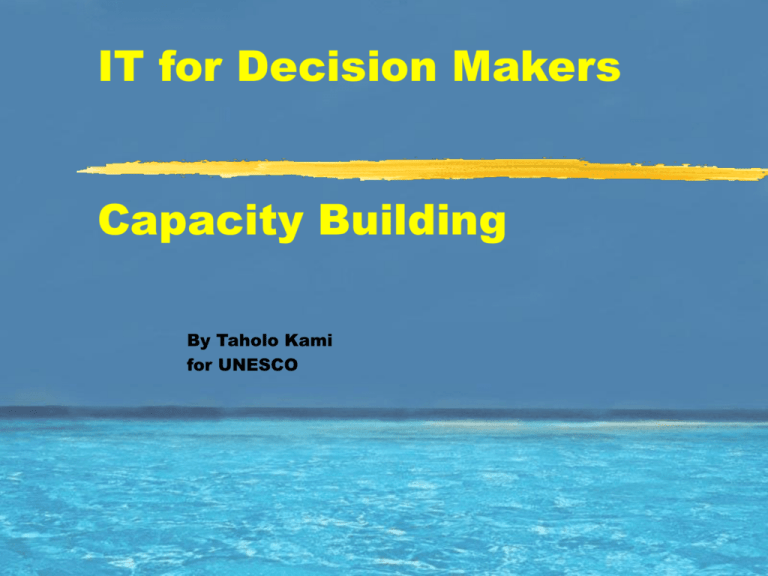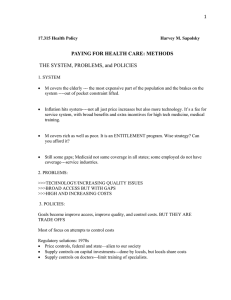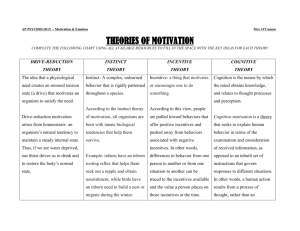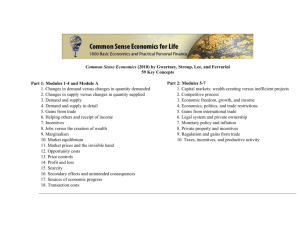Upskilling a Nation - Communication and Information
advertisement

IT for Decision Makers Capacity Building By Taholo Kami for UNESCO Capacity Building Dilemma Human Resource Capacity is only one factor of many other limitations including infrastructure regulatory issues cost of access How do we jump start a nation? Where do we begin? New Zealand in 2001 began developing a fast tracking strategy to upskill the nation FAST TRACKING versus traditional Education strategies Building a knowledge based society is a priority Participation in the global economy is driven by the ability to use information Traditional education strategies are too slow Fast tracking is identifying critical gaps in capacity and focusing resources to close gaps at an accelerated pace Human Resources…. Human dimension is the most important Affordable and fast Internet access without the human capacity to optimize it is poor use of resources. E.g. Fiji’s Southern Cross cable will be incentive to speed development of IT initiatives but until human resources are able to utilize access, it has little impact on development. The Challenge Currently less then 5% of Pacific populations have anything to do with the Internet We lack skills at all levels from general awareness to specialist technical skills to management and leadership. We need to develop cultures that embrace innovation and initiative and support entrepreneurship Who are we Targeting? Government Employees Private Enterprise Civil Society General Public School Students What kind of Skills? Tangibles Administrative Management Operational Technical Legal and Regulatory Security Intangibles Innovation Creativity Initiative Integrity Entrepreneurship Leadership Administrative High level Commitment Agency or multi sectoral mechanism to drive the transformation Necessary resources Management Plan, organize, direct and control activities Define new working procedures and ethics Solve problems and make decisions Establish and maintain good interdisciplinary relations Ensure customer satisfaction through quality control of services and products Operational Capable Manpower Availability of necessary resources Effective operating procedures Good Systems backup services Technical Network hardware and terminal equipment Systems and network software Compatibility with Internet standards Networks and systems integration Upgradable systems and networks Legal and Regulatory Protection of right to privacy Setting and maintenance of Standards of ethics Establishment of framework that effectively deals with computer crime Security Protection of systems hardware Protection of information and database Organizational security Controls over data input, processing and output Intangibles (the “x” factors) Difficult to produce but these are essential “People factors” Long term cultural change Culture of organizations / nation must be addressed Involve Schools, Communities and Families. In the short term spot potential champions at all levels and develop and support Provide Incentives that encourage innovation Highlight successes Assessment Identifying Critical Gaps in Capacity Available Skills Training Facilities Available Resources Assessment Existing Training Facilities Education Institutions Private agencies / facilities Consultants / skilled trainers Internal or In-house facilities Distance education via Internet Overseas Scholarships Fast Tracking Strategy Set Benchmark objectives Must be realistic and attainable Formal Education - examples Every grade 6 primary school student will have basic level computer skills by 200_ All high schools will offer IT courses by 200_ All teachers will have IT usage certificate by _ Technical and tertiary institutions will offer international standard IT courses by 200_ 10 scholarships per year for overseas IT training Benchmarking continued Integrate into workplace – egs All Government employees level 1-9 must have basic IT usage certificate by 200_ All new Government employees must have IT usage certificate Wage increments for further IT training Incentives for private enterprise and institutional employment training schemes by 200? New Tracks….an example Raising awareness and basic IT Skills IT License / Passport Scheme Objective to ensure passport/license holder has basic computer and Internet skills Passport / License holder needs to sit 4 to 5 one hour courses and a test IT license /passport becomes necessary for all employment. Incentives provided to various institutions to provide training Fast Tracking Link to existing Institutions Financial Incentives for institutional participation National recognition of special qualifications Create new tracks… Specialist courses for specific skills Special courses for high level decision makers Incentives that Motivate are those that make sense to individuals own goals Funding Scholarships for overseas training Incentives for new courses in local institutions Incentives to organizations to upskill staff Incentives and funding for new private training programmes Incentives for individuals to participate in special training courses Retention Strategy Cut the Brain Drain / leakage Package Approach Rewards are more then monetary Professional Development Career Progression Peer Recognition Good People build great organizations - great organizations are cornerstones of national development Conclusion Upskilling a nation and creating knowledge society requires Clear and attainable objectives A realistic but often unconventional strategy to achieve objectives Commitment of Resources Remember Upskilling is a continuous process The biggest pool of natural resources in the Pacific are our people….. empowering and enabling the people is the engine for real growth.





